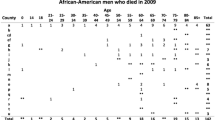Abstract
For decades, NSOs have usedcomplementary cell suppression for disclosure limitation of tabular data, magnitude data in particular. Indications of its continued use abound, even though suppression thwarts statistical analysis of both the expert and the novice. We introduce methods for creating alternative tables that the NSO can release unsuppressed, while ensuring within statistical certainty that their analysis is conformal with analysis of the original.
Access this chapter
Tax calculation will be finalised at checkout
Purchases are for personal use only
Preview
Unable to display preview. Download preview PDF.
Similar content being viewed by others
References
Cox, L.H.: Suppression methodology and statistical disclosure control. Journal of the American Statistical Association 75(370), 377–385 (1980)
Cox, L.H.: Disclosure risk for tabular economic data. In: Doyle, P., Lane, J., Theeuwes, J., Zayatz, L. (eds.) Confidentiality, Disclosure and Data Access: Theory and Practical Applications for Statistical Agencies, ch. 8, pp. 167–183. Elsevier, New York (2001)
Cox, L.H., Karr, A.F., Kinney, S.: Risk-Utility paradigms for statistical disclosure limitation: How to think but not how to act (with discussion). International Statistical Review 2, 160–183 (2011) (with discussion)
Fellegi, I.P.: On the question of statistical confidentiality. Journal of the American Statistical Association 67, 7–18 (1972)
Cox, L.H.: Network models for complementary cell suppression. Journal of the American Statistical Association, 90(432), 1153–1162 (1995)
Dalenius, T.: Towards a methodology for statistical disclosure control. Statist Tidskrift 5, 429–444 (1977)
Federal Committee on Statistical Methodology. Report on Disclosure Limitation Methodology—Statistical Policy Working Paper 22. Office Management & Budget, Washington, DC (Rev: 2006) (1994)
U.S. Department of Commerce. Report on Statistical Disclosure and Disclosure Limitation—Statistical Policy Working Paper 2. Office of Statistical Policy and Standards Washington, DC (1978)
Kelly, J.P., Golden, B.L., Assad, A.A.: Cell suppression: Disclosure protection for sensitive tabular data. Networks 22, 397–417 (1992)
Cox, L.H.: A data quality and data confidentiality assessment of complementary cell suppression. In: Domingo-Ferrer, J., Saygın, Y. (eds.) PSD 2008. LNCS, vol. 5262, pp. 13–23. Springer, Heidelberg (2008)
Cox, L.H.: Vulnerability of complementary cell suppression to intruder attack. Journal of Privacy and Confidentiality 1(2), 235–251 (2009), http://jpc.stat.cmu.edu
Fischetti, M., Salazar, J.J.: Models and algorithnms for optimizing cell suppression in tabular data with linear constraints. Journal of the American Statistical Association 95, 916–928 (2000)
Fischetti, M., Salazar, J.J.: Solving the cell suppression problem in tabular data with linear constraints. Management Science 47(7), 1008–1026 (2001)
Cox, L.H.: Contingency tables of network type: Models, Markov basis and applications. Statistica Sinica 17(4), 1371–1393 (2007)
Dobra, A., Fienberg, S.E.: Bounds for cell entries in contingency tables given marginal totals and decomposable graphs. Proceedings of the National Academy of Sciences 97(22), 11885–11892 (2000)
Salazar, J.J.: Statistical confidentiality: Optimization techniques to protect tables. Computers & Operations Research 35, 1638–1651 (2008)
Cox, L.H., Kelly, J.P., Patil, R.: Balancing quality and confidentiality for multivariate tabular data. In: Domingo-Ferrer, J., Torra, V. (eds.) PSD 2004. LNCS, vol. 3050, pp. 87–98. Springer, Heidelberg (2004)
Cox, L.H., Orelien, J.G., Shah, B.V.: A method for preserving statistical distributions subject to controlled tabular adjustment. In: Domingo-Ferrer, J., Franconi, L. (eds.) PSD 2006. LNCS, vol. 4302, pp. 1–11. Springer, Heidelberg (2006)
Raghunathan, T.E., Reiter, J.P., Rubin, D.B.: Multiple imputation for statistical disclosure limitation. Journal of Official Statistics 19, 1–16 (2003)
Reiter, J.P.: Satisfying disclosure restrictions with synthetic data sets. Journal of Official Statistics 18, 531–544 (2002)
Reiter, J.P.: Releasing multiply-imputed, synthetic public use microdata: An illustration and empirical study. Journal of the Royal Statistical Society, Series A 168, 185–205 (2005)
Wooton, J., Fraser, B.: A review of confidentiality protections for statistical tables, with special reference to the differencing problem. Australian Bureau of Statistics Methodology Report 1352.0.55.072. Australian Bureau of Statistics, Canberra (2005)
Isserman, A.M., Westervelt, J.: 1.5 million missing numbers: overcoming employment suppression in County Business Patterns data. International Regional Science Review 29(3), 311–335 (2006)
Cox, L.H.: On properties of multi-dimensional statistical tables. Journal of Statistical Planning and Inference 17(2), 251–273 (2003)
Cox, L.H.: Inference control problems in statistical database query systems. In: Farkas, C., Samarati, P. (eds.) Research Directions in Data and Applications Security, pp. 1–13. Kluwer, Boston (2004)
Author information
Authors and Affiliations
Editor information
Editors and Affiliations
Rights and permissions
Copyright information
© 2014 Springer International Publishing Switzerland
About this paper
Cite this paper
Cox, L.H. (2014). Enabling Statistical Analysis of Suppressed Tabular Data. In: Domingo-Ferrer, J. (eds) Privacy in Statistical Databases. PSD 2014. Lecture Notes in Computer Science, vol 8744. Springer, Cham. https://doi.org/10.1007/978-3-319-11257-2_1
Download citation
DOI: https://doi.org/10.1007/978-3-319-11257-2_1
Publisher Name: Springer, Cham
Print ISBN: 978-3-319-11256-5
Online ISBN: 978-3-319-11257-2
eBook Packages: Computer ScienceComputer Science (R0)




